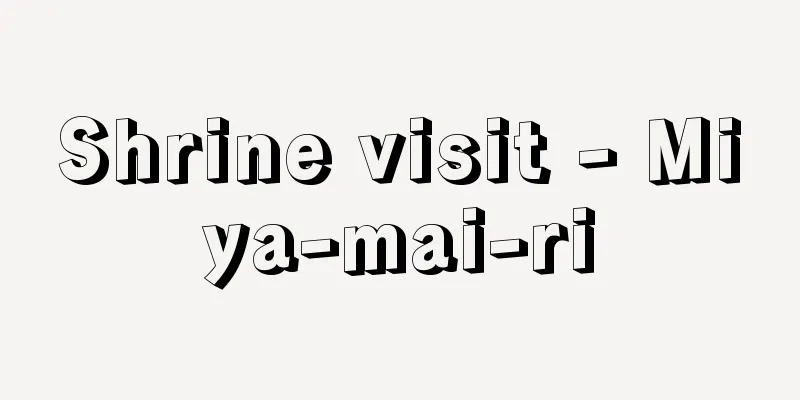Shrine visit - Miya-mai-ri

|
The first visit to the ujigami after birth to become a parishioner is also called Hatsumiya-mairi. The date is usually around 30 days, but in some places it is on the seventh night, and in some cases it is around 100 days. The Hatsumiya-mairi is called Hiake, Hihare, Shimeage, Ubuake, etc. because on this day the taboo against the newborn baby is lifted, and the first visit to the ujigami is made after the birth house is opened. The taboo against childbirth is said to be most severe on the mother, followed by the newborn baby, then the husband, and then the family, in that order. Therefore, after the taboo against both mother and child is lifted, in some places the visit is made on the 75th or 100th day, and in western Japan it is called Momoka-mairi, and is often made on the 100th day. In some places, the Miya-mairi held around 30 days ago is called Torii-mairi, and the visit only goes as far as the torii gate. Of course, one reason is that the mother's taboo has not yet ended, but it also depends on the strength of the local taboo against childbirth. The matchmaker's wife, midwife, mother-in-law, etc., bring the baby dressed in haregi. The purpose of these visits, called ujimise or genzo (visiting the shrine), is to introduce the new parishioner to the local deity, and they deliberately make the child cry to impress the deity and pray for future protection. Red rice and sacred sake are offered in front of the shrine, and the red rice is given to the neighborhood children who follow them, little by little, as they join the group. On the way back from the shrine visit, the relatives who gave them the gifts are called back, and they are asked to tie a 'shiraga' (a sacred item) to the baby's baby clothes and are blessed with a long life. The shrine visit was also the first procedure for the newborn baby to be socially accepted and become a member of the community. [Yuki Ofuji] "Family Chat" (included in "The Complete Works of Yanagita Kunio Vol. 15", 1963, Chikuma Shobo) " Compilation of Japanese Child Rearing Customs and Folklore Materials" edited by the Imperial Gift Foundation Mother and Child Care Association (1975, Daiichi Hoki Publishing) "Child Raising" by Ofuji Yuki (1968, Iwasaki Bijutsusha) [Reference] |Source: Shogakukan Encyclopedia Nipponica About Encyclopedia Nipponica Information | Legend |
|
生後初めて氏神に参って氏子となることで、初宮参りともいう。日取りは30日前後が多く、所によってお七夜にする所もあり、100日ごろにする例もある。初宮参りをヒアケ、ヒハレ、シメアゲ、ウブアケなどというのは、この日で生児の忌みが晴れるので、産屋明けに氏神への初参りをするのである。産の忌みはコユミ(子忌み)三三日、オヤユミ(親忌み)七五日といわれるように、産婦にもっとも重く、ついで生児、次に夫、家族という順になっている。したがって、母子双方の忌み明けを待って、75日、100日目に参る所や、西日本ではモモカマイリといって100日目に参る例が多い。30日前後の宮参りに鳥居参りといって、鳥居までしか参らぬ所がある。もちろん母親の忌みが明けぬことも理由の一つであるが、その地方の産の忌みの観念の強さにもよる。仲人(なこうど)の女親(仲人の妻)や産婆、姑(しゅうとめ)などがハレギを着せた児を抱いて参る。氏見せ、ゲンゾ(見参)参りなどといって、新しい氏子を氏神に引き合わせるのが目的で、わざと子を泣かせたりして、神に印象づけ将来の加護を祈る。社前に赤飯や御神酒(おみき)を供え、赤飯はついてきた近所の子供たちに、お仲間入りといってすこしずつふるまう。宮参りの帰りには祝いをもらった親戚(しんせき)へ寄り、シラガというオヒネリを産着の紐(ひも)に結んでもらって、長生きするように祝ってもらう。宮参りは生児が初めて社会的に承認され、地域の一員となるという第一の手続でもあった。 [大藤ゆき] 『『家閑談』(『定本柳田国男集15』所収・1963・筑摩書房)』▽『恩賜財団母子愛育会編『日本産育習俗資料集成』(1975・第一法規出版)』▽『大藤ゆき著『児やらい』(1968・岩崎美術社)』 [参照項目] |出典 小学館 日本大百科全書(ニッポニカ)日本大百科全書(ニッポニカ)について 情報 | 凡例 |
<<: Mountain parrot (Miyama Parrot) - Miyama Parrot (English spelling) kea
Recommend
Barley - Mugi
Wheat and barley are collectively called "mu...
Blackett, Patrick Maynard Stuart, Baron
Born: November 18, 1897, London [Died] July 13, 19...
Songhai people - Songhai (English spelling)
An ethnic group living along the Niger River in Ma...
Frascati (English spelling)
A resort town in the province of Rome, Lazio, in c...
Sasuke Okuno - Sasuke Okuno
?-? A Kabuki composer from the mid-Edo period. He...
Cobitis
...A freshwater fish of the family Cobicidae. The...
denar (English spelling)
… The Sassanid monetary system showed many new fe...
Teutonic
...The origin of the name Germanic is unknown, bu...
Irony - Irony (English spelling)
In Japanese, it is translated as "irony"...
Parrot echo, literary and martial arts - Parrot echo, literary and martial arts
Yellow cover. 3 volumes. Written by Koikawa Haruma...
Tannin
Also called tannin. A common general name for a g...
Gymnocarpium jessoensis (English spelling) Gymnocarpium jessoensis
…[Masahiro Kato]. . . *Some of the terminology th...
Yellow-legged wasp - Yellow-legged wasp
...They hunt moth larvae and store them in their ...
Monks - Bouzushu
A status of monks in medieval and early modern Jap...
Discomfort index - Fukai Shisuu
The degree of hotness, coldness, coolness or warm...









